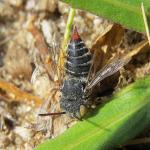A photographic test key by Rowson & Pavett (2008) is available via the BWARS website. Else and Edwards cover Coelioxys in their new book Handbook of the Bees of the British Isles, which is due for publication soon.
Coelioxys brevis is absent from the British mainland and only found on Jersey in the Channel Islands.
In Europe, it is found from Spain, through France and across to Germany and Poland. It is also recorded from the Ukraine, Italy, Sardinia and Hungary. Further afield, it is recorded from North Africa. It has also been recorded eastwards to Iraq, India and Japan (Else, in prep.).
The Channel Islands, for a number of reasons, are excluded from the geographical coverage of the British Red Data book (Shirt, 1987).
On Jersey, Coelioxys brevis is only found on coastal dunes (Richards, 1979).
Coelioxys brevis has a late flight period of mid-August to early October (Else, in prep.).
The females of all but one British species of Coelixoys have a pointed sixth tergite and sternite which is apparently used to cut open the cell wall or cap of the host species. An egg is laid in this slit with at least one third protruding through into the cell or laid directly onto the host egg. Generally, Coelioxys larvae kill, and in some species eat, the host egg immediately on hatching. Pupation occurs within a cocoon spun within the host cell where the larvae overwinters as a pre-pupa, prior to final pupation, presumably in spring of the following year.
There is no information on flower visiting by Coelioxys brevis on the Channel Islands. Stöckhert (1933), in Germany, cites reflexed stonecrop, viper’s bugloss, breckland thyme and knapweed species as being visited by this species.
No data available.
2016


